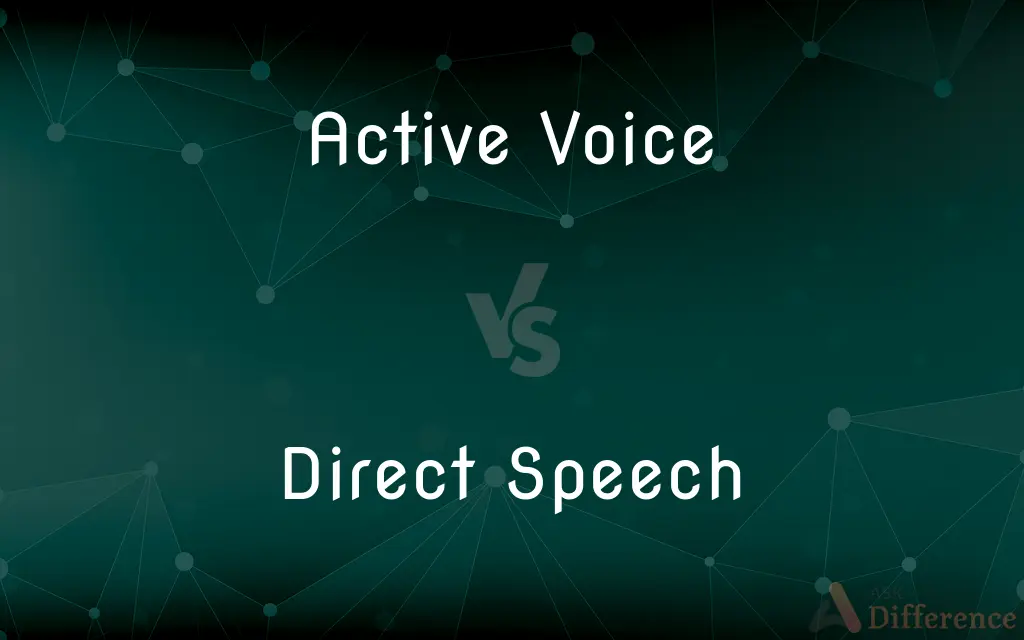Active Voice vs. Direct Speech — What's the Difference?
By Tayyaba Rehman — Published on January 23, 2024
Active Voice is a grammatical voice where the subject performs the action of the verb, while Direct Speech involves quoting the exact words spoken by someone.

Difference Between Active Voice and Direct Speech
Table of Contents
ADVERTISEMENT
Key Differences
Active Voice is a structure in grammar where the subject of the sentence performs the action stated by the verb, emphasizing the doer of the action. It is direct and straightforward. Direct Speech, on the other hand, is a way of reporting speech by quoting the exact words spoken by a person, often enclosed in quotation marks and accompanied by a speech tag.
In Active Voice, the focus is on the action and who is performing it. For example, "The dog chased the cat." The dog (subject) is actively doing the chasing (verb). In Direct Speech, the emphasis is on relaying the exact words spoken, as in, "He said, 'I will be late.'"
Active Voice is often preferred in writing for its clarity and conciseness. It makes the sentences more engaging and dynamic. Conversely, Direct Speech is used to convey the tone, mood, and exact phrasing of someone's words, providing a clear context in conversations or reports.
Active Voice is a key element in constructing clear and effective sentences in both spoken and written English. Direct Speech is commonly used in storytelling, dialogues in plays, and in reported speech to convey authenticity and immediacy.
While Active Voice contributes to the overall style and clarity of writing, Direct Speech is essential for maintaining the originality of spoken words and is a vital tool in creative writing and journalism.
ADVERTISEMENT
Comparison Chart
Definition
Subject performs the action
Quoting exact words spoken
Usage
In general writing for clarity
In reporting speech, dialogues
Focus
On the action and its performer
On the original words and tone
Effect
Creates engaging, dynamic sentences
Provides context and authenticity
Example
"The cat drinks milk."
"She said, 'I love this song.'"
Compare with Definitions
Active Voice
Preferred for its conciseness.
The gardener waters the plants.
Direct Speech
Includes a speech tag.
The teacher said, 'Homework is due tomorrow.'
Active Voice
Enhances sentence dynamism.
The athlete won the race.
Direct Speech
Conveys tone and mood.
He whispered, 'I have a secret.'
Active Voice
Subject acts in the sentence.
The chef cooks the meal.
Direct Speech
Used in dialogues and reporting.
'It's a beautiful day,' she observed.
Active Voice
Direct and clear sentence construction.
Students write their exams.
Direct Speech
Quoting someone's exact words.
He exclaimed, 'What a fantastic show!'
Active Voice
Emphasizes the doer of an action.
Birds chirp melodiously in the morning.
Direct Speech
Enclosed in quotation marks.
She asked, 'Will you join us for dinner?'
Common Curiosities
What is active voice in grammar?
Active voice is a sentence structure where the subject performs the action of the verb.
Why is active voice preferred in writing?
Active voice is preferred for its clarity, directness, and ability to make sentences more engaging.
How is direct speech used in writing?
Direct speech is used to quote exactly what someone has said, often in dialogues or narration.
How does active voice affect sentence structure?
Active voice places the subject at the beginning of the sentence, making the doer of the action clear.
Can direct speech be used in formal writing?
Yes, direct speech can be used in formal writing, especially when quoting someone or in creative works.
Can direct speech change the tone of a narrative?
Yes, direct speech can convey the speaker’s tone, emotion, and personality, impacting the overall narrative tone.
How does direct speech enhance storytelling?
Direct speech adds authenticity and immediacy to dialogue, making storytelling more engaging.
When should you use active voice?
Active voice should be used when you want to create straightforward, clear, and concise sentences.
What is an example of active voice?
An example of active voice is, "The dog chased the cat."
Can changing from passive to active voice alter the sentence's meaning?
Changing from passive to active voice can shift the focus of the sentence but usually retains the overall meaning.
What are the components of direct speech?
Direct speech includes the exact words spoken, enclosed in quotation marks, and often a speech tag.
Is passive voice the opposite of active voice?
Yes, in passive voice, the subject is acted upon, as opposed to performing the action in active voice.
How do you identify direct speech in a text?
Direct speech is usually identified by quotation marks and a speech tag indicating the speaker.
Is active voice always better than passive voice?
While active voice is often preferred for clarity, passive voice can be useful in specific contexts where the focus is on the action rather than the doer.
What punctuation is used in direct speech?
Quotation marks are used to enclose the spoken words in direct speech.
Share Your Discovery

Previous Comparison
March Past vs. Parade
Next Comparison
38 vs. 38 SpecialAuthor Spotlight
Written by
Tayyaba RehmanTayyaba Rehman is a distinguished writer, currently serving as a primary contributor to askdifference.com. As a researcher in semantics and etymology, Tayyaba's passion for the complexity of languages and their distinctions has found a perfect home on the platform. Tayyaba delves into the intricacies of language, distinguishing between commonly confused words and phrases, thereby providing clarity for readers worldwide.
















































